Are you looking to maintain the health of your trees and enhance your garden’s appeal but find yourself puzzled by where trimming ends and pruning begins? The key difference between trimming and pruning lies in the distinct objectives each achieves: trimming shapes your trees and shrubs to reinforce the landscape’s aesthetics, while pruning focuses on the health of your trees by removing diseased or dead branches. In this article, we’ll dissect these crucial horticultural practices, outline their optimal timings, and provide you with the insights needed to execute them correctly for a thriving garden.
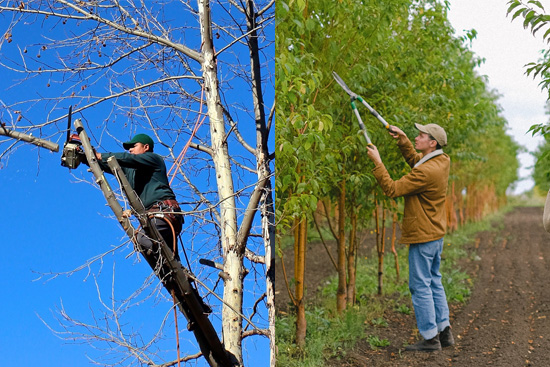
Key Takeaways
• Tree trimming focuses on enhancing the tree’s shape and aesthetic appeal, allowing sunlight and moisture to reach vegetation underneath, while pruning aims to remove dead or diseased limbs to improve tree health and prevent disease spread.
• The timing of tree trimming and pruning is critical for the health of the tree, with trimming usually recommended in late fall or early spring and pruning outside of growing seasons, but varying based on tree species and flowering times.
• Employing certified arborists for tree trimming and pruning ensures proper techniques and safety measures, minimizes damage and risks associated with DIY approaches, and preserves tree health and property values.
Understanding the Fundamentals: Trimming & Pruning Explained
Though often used interchangeably, tree trimming and pruning serve distinct purposes in tree care. Tree trimming primarily focuses on maintaining the tree’s shape and appearance, enhancing its natural form, and controlling overgrown branches. Regular tree trimming contributes to the health and longevity of trees, ensuring they grow strong and retain their aesthetic appeal over time.
Conversely, tree pruning focuses on removing dead or diseased limbs to boost tree health. It mitigates the risk of spreading diseases to other parts of the plant and ensures efficient nutrient uptake, fostering a robust and healthy structure conducive to the tree’s proper growth. Pruning is important because inappropriate pruning practices can lead to weakened structures, increased pest infestation, disease risks, and an overall decline in tree health.
Additionally, pruned trees improve weather conditions by naturally lowering temperatures and air moisture levels, fostering a more comfortable and sustainable garden environment.
The Aim of Tree Trimming
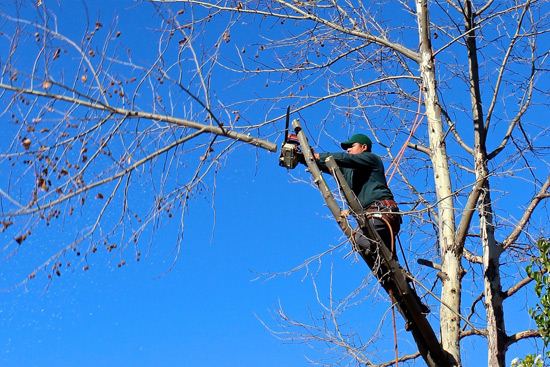
Tree trimming aims to accentuate the tree’s natural shape and manage overgrown branches, thereby improving its aesthetic appeal. It is an essential aspect of tree care that helps maintain an aesthetically pleasing form of the tree, contributing to the overall appeal of your garden.
Moreover, controlling overgrown branches through trimming is not just about aesthetics. It also plays a vital role in the tree’s health and the underlying vegetation. Effective trimming allows sunlight and moisture to reach the underlying vegetation more effectively, promoting their growth. Additionally, removing loose branches and unnecessary branches can prevent potential hazards and damage to the surrounding area and curb unwanted growth.
Thus, tree trimming and pruning are integral to maintaining healthy trees and a vibrant garden.
The Purpose of Tree Pruning
Rather than focusing on aesthetics like trimming, tree pruning fulfills a more significant role. It is imperative for:
• Removing dead or diseased limbs
• Enhancing the tree’s health
• Mitigating the risk of spreading diseases to other parts of the plant
• Supporting efficient nutrient uptake
• Preventing root loss
• Fostering a strong, healthy structure conducive to the tree’s proper growth.
Regular pruning is essential for maintaining your trees’ overall health and well-being, and hiring professional pruning services can ensure the job is done correctly.
Nevertheless, it should be recognized that incorrect pruning techniques can result in a general deterioration of tree health. Over-pruning and tree topping can weaken the tree’s structure and increase pest infestation and disease risks.
On the other hand, appropriately pruned dormant trees improve weather conditions by naturally lowering temperatures and air moisture levels, fostering a more comfortable and sustainable garden environment.
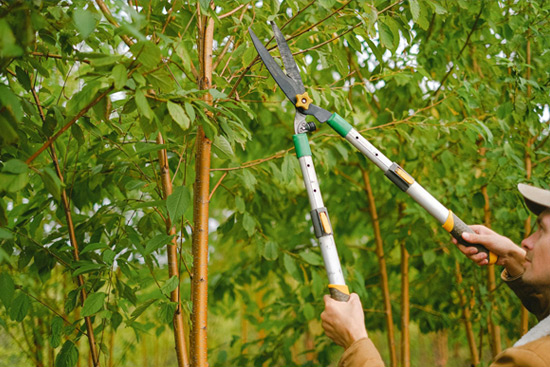
The Right Time for Trimming vs Pruning
The success of tree trimming and pruning significantly depends on their timing. It’s about knowing how to trim or prune and when to perform these tasks. Both practices have different optimal timings, influenced by factors such as tree species, growth cycle, and seasonal changes.
It is generally advised to trim trees in the fall and prune them outside the growing season. Moreover, avoiding pruning or trimming during extreme weather conditions is critical, as it can lead to stress and potential injury to trees and plants.
We’ll explore the best timing for both practices in more detail.
Best Season for Tree Trimming
Tree trimming is best done in late fall or early spring, avoiding the tree’s growing season. The worst time to trim trees is in the spring, just after they have budded out, as the trees will not recover from trimming as well or as quickly. Trimming trees in the fall and winter is beneficial because the trees’ internal systems begin to slow as they prepare to go dormant, which helps the trees heal from pruning wounds before disease and insects arrive in the spring.
Still, one should be aware that regardless of timing, improper trimming methods like over-trimming, lion-tailing, or topping can harm the tree. While winter is often recommended for pruning as it benefits the plant’s health, there are exceptions based on tree species and desired outcomes.
Ideal Timing for Tree Pruning
Similar to trimming, the timing of pruning is vital for the tree’s health and productivity. Pruning trees outside their growing season is recommended to promote successful recovery. The flowering season of the tree also plays a vital role in determining the best time for pruning. For instance, spring flowering trees should be pruned after flowering to promote healthy new growth, while summer flowering trees benefit from pruning in late winter or early spring before dormancy ends.
Moreover, the timing for pruning can vary depending on the type of tree. Newly planted trees typically only require corrective pruning in the initial years after planting, while subtropical trees can be pruned year-round due to their continuous growth cycle. Understanding these nuances can significantly contribute to your trees’ successful growth and health.
Techniques and Tools: Pruning Methods and Equipment
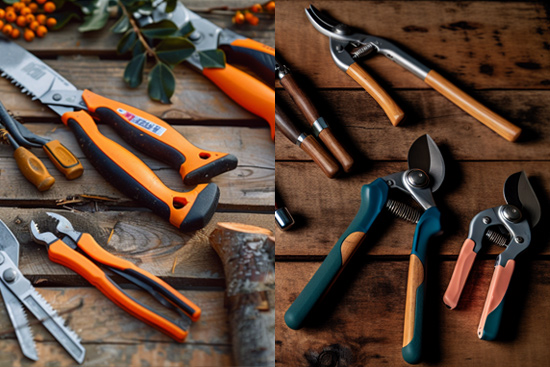
Comprehending the correct techniques and tools holds equal importance to understanding the basics of trimming and pruning. There are various pruning methods, each serving a unique purpose, and the choice of method depends on the tree’s specific needs. Some common pruning methods include:
• Crown thinning
• Crown raising
• Crown reduction
• Crown cleaning
Beyond techniques, possessing the appropriate tools is crucial for successful pruning. Hand shears for cutting live stems and branches and lopping shears for thicker branches are some of the tools needed for pruning. Furthermore, it’s important to understand the difference between bypass and anvil pruning tools and their specific applications for making clean cuts and promoting healing and growth.
Selecting Pruning Techniques
Choosing the appropriate pruning technique is fundamental to effective tree care. Each tree has specific needs and requires a particular approach to pruning. For instance, dead, diseased, or damaged branches on conifers should be pruned as soon as problems arise to maintain tree health. An arborist can determine the type of pruning necessary for improving a tree’s health, appearance, and safety.
However, it’s not just about selecting the right technique. Making the correct cuts during pruning is essential. This holds true for all pruning methods. For example, crown thinning should be performed carefully to avoid excessive removal of foliage, which can stress the tree and lead to structural problems. Thus, understanding these nuances and applying them correctly can significantly enhance the effectiveness of tree pruning.
Essential Tools for Effective Pruning
Appropriate tools are as necessary as correct techniques for effective pruning. Hand shears are a crucial tool for pruning smaller shrubs and branches. Lopping shears are used for thicker branches that hand shears cannot easily cut through. However, poorly maintained shears can cause jagged cuts or bark tearing, exposing the plant to pests and diseases.
Understanding the difference between bypass and anvil pruning tools can also contribute to more efficient and effective pruning. Bypass pruning tools make clean cuts by bypassing a non-cutting hook to support the branch, promoting healing and growth. On the other hand, anvil pruning tools, ideal for cutting hard deadwood, feature a sharpened “V” shaped blade, preventing damage to the blade. Thus, using the right tools and maintaining them properly is crucial in effective pruning.
How Tree Trimming Enhances Your Yard
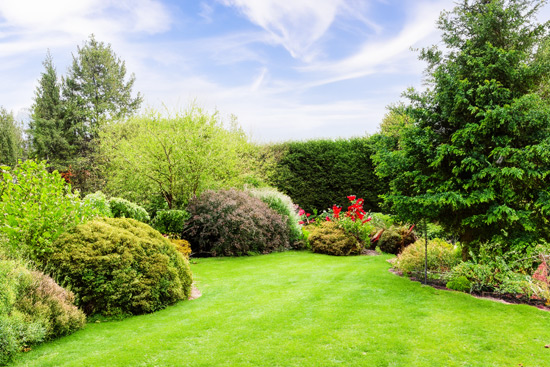
Tree trimming exceeds just preserving the tree’s shape and appearance; it substantially enhances the overall aesthetics of your yard. It allows for improved sunlight penetration and moisture distribution to the grass and flowers beneath, providing them with the necessary conditions for healthy growth.
Furthermore, well-groomed and trimmed trees can amplify the attractiveness of a property, potentially boosting its market value.
Benefits of Regular Trimming
Frequent tree trimming provides several advantages to both the trees and the entire landscape. Some of these advantages include:
• Maintaining a uniform and pleasing tree-shape
• Controlling tree growth
• Enhancing safety by ensuring a safe distance from power lines and building structures
Moreover, regular trimming has several benefits:
• Reduces competition for resources among branches, promoting a healthier and more visually appealing tree structure
• Maintains a uniform tree shape, enhancing the overall appeal of your garden
• Contributes to a neater yard
• It is a critical aspect of comprehensive tree care and landscape management.
Tree Trimming Impact on Plant Health and Environment
Tree trimming notably influences the health of plants and the environment. It increases sunlight exposure to tree leaves, enhancing photosynthesis and overall tree growth potential. Regular trimming allows increased sunlight and air to reach inner branches and leaves, stimulating new growth and maintaining tree health.
Improved airflow and sunlight penetration from regular trimming have several benefits for trees:
• Reduce the risk of fungal growth and other diseases, contributing to plant health
• Contribute to improved air quality
• Make trees less likely to succumb to diseases or pests
• Filter pollutants out of rainwater, benefiting the whole garden ecosystem
Tree trimming helps trees by playing a crucial role in maintaining their health and vitality, ensuring trees’ healthy growth, removing dead branches, and promoting a healthier environment for tree branches to grow.
Even for fruit trees, thinning overgrown branches and removing thick branches increases energy production due to better light penetration, resulting in fruit that suffers less bruising and scarring.
Professional Care: Why Hire Certified Arborists?
While one can carry out basic trimming and pruning tasks independently, employing certified arborists guarantees secure, ethical, and informed tree care. Certified arborists are required to engage in continuous education to maintain their certification, ensuring they utilize the latest arboricultural techniques.
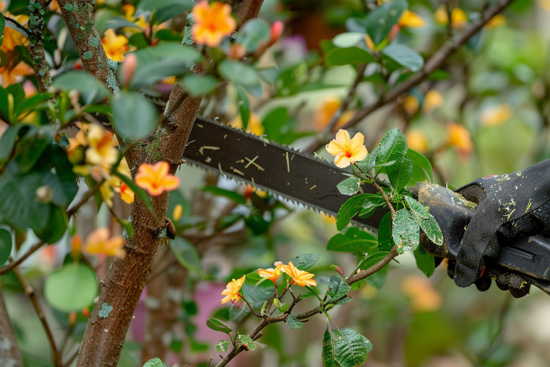
They commit to safe and ethical practices in tree care, minimizing the risk of damage to property and injury to individuals.
Advantages of Expert Trimming and Pruning
Employing expert arborists for trimming and pruning brings along several benefits. They have the necessary skills and knowledge to ensure proper care for the tree’s health and strength. They are adept at using the right equipment and techniques to avoid plant risks and harm.
Expert pruning by qualified arborists is essential due to the complexity of the task. They know the proper size pruning tools crucial for achieving greater control and comfort during pruning tasks. Furthermore, they understand that trees have a natural process of healing from pruned wounds, and sealing or painting these wounds can interfere with this process.
Risks of DIY Trimming and Pruning
While DIY trimming and pruning may appear cost-effective, it can be hazardous and result in prolonged damage to trees. The risks associated with DIY tree care include potential falls, cuts, or electrocution when working near power lines. Moreover, emergency care of storm-damaged trees can be hazardous, requiring professional arborists to perform the job safely and prevent further risk to property and individuals.
Incorrect DIY pruning or trimming can lead to damaged branches, diseased branches, and wounds that cause long-term tree damage. Homeowners may be liable for injuries or damages that occur during DIY tree maintenance or if they hire unlicensed individuals, emphasizing the importance of hiring professionals with the right credentials.
Tailoring to Tree Types: Special Considerations
Various tree types necessitate customized approaches to trimming and pruning. The approach to a fruit tree will vastly differ from that of a conifer or an ornamental tree. Understanding these subtle differences is essential to ensuring the overall health and growth of the tree.
Customized Approach for Fruit Trees
Pruning requirements are quite specific for fruit trees. Correct pruning boosts flower production, optimizes fruit yields, and prevents the stunting of growth and spread of pests and diseases. Pome fruit trees like apples and pears benefit from central leader pruning for a strong trunk and pyramid shape, while stone fruit trees require an open vase style for better light and airflow.
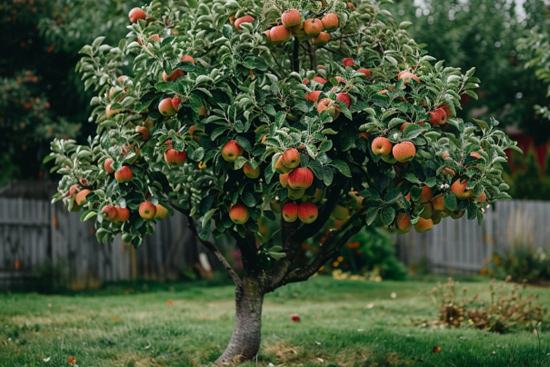
Moreover, the timing for pruning fruit trees can significantly influence their health and fruit production. For instance, fruit trees should undergo structural pruning in winter and trimming post-bloom in early spring for healthy growth and fruit production.
Aesthetic Trimming for Ornamental Trees
Pruning ornamental trees, renowned for their aesthetic charm, requires a distinct approach. Specific pruning techniques such as shearing, removing shoots or suckers, and renewal or rejuvenation pruning are essential for maintaining artificial shapes, like espaliered trees or topiary.
Pruning weeping trees requires a delicate approach to maintain their distinctive branching patterns and to prevent a common shaping mistake of creating a uniform mushroom shape. Thus, understanding these nuances and applying the right pruning methods can enhance the natural beauty of ornamental trees, adding an extra charm to your garden.
Summary of Tree Trimming vs Pruning
We’ve explored the fascinating world of tree trimming and pruning, delving deep into their fundamentals, techniques, and best practices. The importance of these practices in maintaining healthy trees and a beautiful garden cannot be overstated. From understanding the specific goals of trimming and pruning to the timing, techniques, and tools used in these practices, we’ve seen that each aspect plays a crucial role in effective tree care.
Whether you’re a homeowner looking to enhance the aesthetics of your yard or a professional landscaper aiming to deliver the best results for your clients, the knowledge you’ve gained from this guide will undoubtedly be valuable. Remember, healthy trees don’t just happen; they result from consistent care, proper techniques, and a deep understanding of their unique needs. So, let’s put this knowledge into practice and contribute to a greener and healthier environment!
Frequently Asked Trimming and Pruning Questions
These are the most common frequently asked questions:
Is pruning and trimming the same?
No, pruning removes unnecessary branches, while trimming promotes healthy growth through separate techniques and equipment.
What does trimming the tree mean?
Trimming the tree means removing unnecessary branches to promote healthy growth of the remaining branches and leaves. This process is typically done using shears.
What is the difference between pruning and cutting off?
Pruning involves removing dead or diseased branches to maintain a plant’s health, while trimming is the process of cutting away overgrowth on plants to keep them looking neat. Both are essential for the well-being of trees and shrubs.
What tools are essential for effective pruning?
To effectively prune, essential tools include hand shears for live stems and branches and lopping shears for thicker branches. Using the right tools ensures a successful pruning process.
What are the benefits of hiring certified arborists for tree care?
Hiring certified arborists for tree care brings the benefits of safe, ethical, and knowledgeable practices, minimizing the risk of damage and injury. This ensures that the latest arboricultural techniques are used, promoting safety and ethical standards in tree care.
This article was first published on: https://www.72tree.com/tree-trimming-vs-pruning/
No comments:
Post a Comment
Note: Only a member of this blog may post a comment.